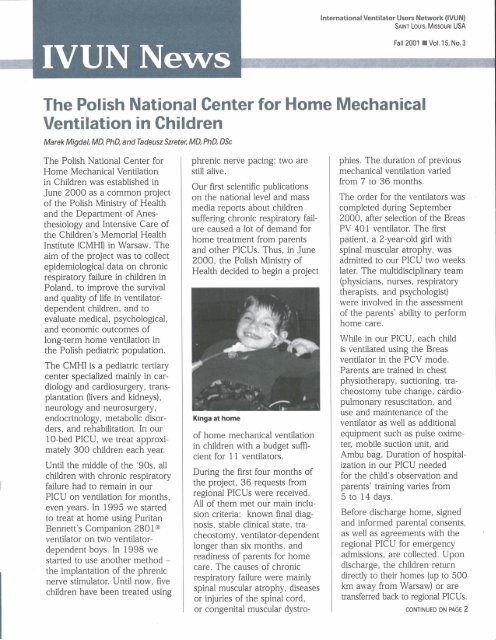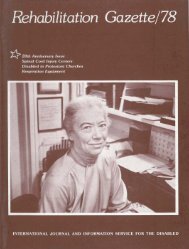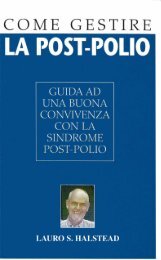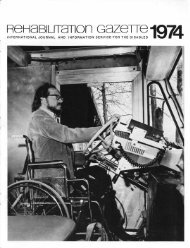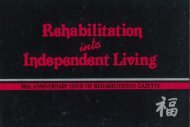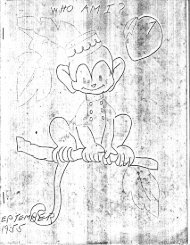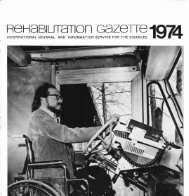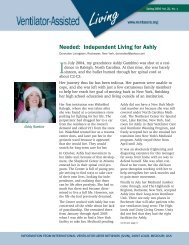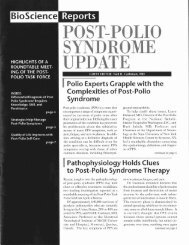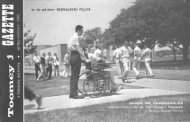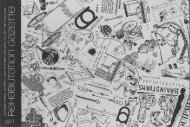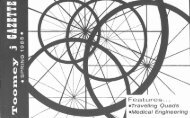IVUN News (Fall 2001, Vol. 15, No. 3) - Polio Place
IVUN News (Fall 2001, Vol. 15, No. 3) - Polio Place
IVUN News (Fall 2001, Vol. 15, No. 3) - Polio Place
You also want an ePaper? Increase the reach of your titles
YUMPU automatically turns print PDFs into web optimized ePapers that Google loves.
International Ventilator Users Network (<strong>IVUN</strong>)SAINT LOUIS, MISSOURI USA<strong>Fall</strong> <strong>2001</strong> H <strong>Vol</strong>. <strong>15</strong>, <strong>No</strong>. 3The Polish National Center for Home MechanicalVentilation in ChildrenMarek Migdal, MD, PhD, and Tadeusz Szreter, MD, Ph Dl DScThe Polish National Center forHome Mechanical Ventilationin Children was established inJune 2000 as a common projectof the Polish Ministry of Healthand the Department of Anesthesiologyand Intensive Care ofthe Children's Memorial HealthInstitute (CMHI) in Warsaw. Theaim of the project was to collectepidemiological data on chronicrespiratory failure in children inPoland, to improve the survivaland quality of life in ventilatordependentchildren, and toevaluate medical, psychological,and economic outcomes oflong-term home ventilation inthewpolish pediatric population.The CMHI is a pediatric tertiarycenter specialized mainly in cardiologyand cardiosurgery, transplantation(livers and kidneys),neurology and neurosurgery,endocrinology, metabolic disorders,and rehabilitation. In our1 0-bed PICU, we treat approximately300 children each year.Until the middle of the '90s, allchildren with chronic respiratoryfailure had to remain in ourPICU on ventilation for months,even years. In 1995 we startedto treat at home using PuritanBennett's Companion 280 1 @ventilator on two ventilatordependentboys. In 1998 westarted to use another method -the implantation of the phrenicnerve stimulator. Until now, fivechildren have been treated usingphrenic nerve pacing; two are1 still alive.Our first scientific publicationson the national level and massmedia reports about childrensuffering chronic respiratory failurecaused a lot of demand forhome treatment from parentsand other PICUs. Thus, in June2000, the Polish Ministry ofHealth decided to begin a projectIKinga at homeof home mechanical ventilationin children with a budget sufficientfor 1 1 ventilators.During the first four months ofthe project, 36 requests fromregional PICUs were received.All of them met our main inclusioncriteria: known final diagnosis,stable clinical state, tracheostomy,ventilator-dependentlonger than six months, andreadiness of parents for homecare. The causes of chronicrespiratory failure were mainlyspinal muscular atrophy, diseasesor injuries of the spinal cord,or congenital muscular dystro-Iphies. The duration of previousmechanical ventilation variedfrom 7 to 36 months.The order for the ventilators wascompleted during September2000, after selection of the BreasPV 40 1 ventilator. The firstpatient, a 2-year-old girl withspinal muscular atrophy, wasadmitted to our PICU two weekslater. The multidisciplinary team(physicians, nurses, respiratorytherapists, and psychologist)were involved in the assessmentof the parents' ability to performhome care.While in our PICU, each childis ventilated using the Breasventilator in the PCV mode.Parents are trained in chestphysiotherapy, suctioning, tracheostomytube change, cardiopulmonaryresuscitation, anduse and maintenance of theventilator as well as additionalequipment such as pulse oximeter,mobile suction unit, andAmbu bag. Duration of hospitalizationin our PICU neededfor the child's observation andparents' training varies from5 to 14 days.Before discharge home, signedand informed parental consents,as well as agreements with theregional PICU for emergencyadmissions, are collected. Upondischarge, the children returndirectly to their homes (up to 500km away from Warsaw) or aretransferred back to regional PICUs.I CONTINUED ON PAGE 2
The Polish National CenterCONTINUED FROM PAGE 1Among 14 children alreadyenrolled in the project, 10 arecurrently at home, two died athome, and two are waiting forventilators at regional PICUs.Children who are at home areunder the care of family doctors,however, we visit themevery three to six months. Firstresults confirmed that homeventilation is safe and effective.The need for antibiotic usebecause of respiratory tractinfections has been significantlyreduced (less than one treatmentper child during the last sixmonths). <strong>No</strong>ne of the childrenreleased home have had to bereadmitted to the hospital.Current major problems areslow progress, financial problemsof parents, and lack ofclear national regulations. Slowprogress is mainly due to thehigh number of acute cases inour PICU. Delayed dischargehome is linked to the financialproblems of parents. Only thehome ventilator is provided bythe CMHI, and additional equipmentmust be purchased byparents or charity funds. Fundsfor disposable supplies neededfor the home care are refundedby only a few of 17 independentregional funds.Despite all of these problems,we expect that home care forventilator-dependent childrenwill continue to grow in Poland.Using the additional funds fromthe Ministry of Health as well asfrom private sponsors, we planto increase the number on homeventilation during 200 1 to 20children. We hope that throughour project all of them will besafely and effectively managedat home for a long period.ADDRESS: Marek Migdal, MD, PhD,Professor and Consultant in Pediatriclntensive Care Unit, and Tadeusz Szreter,MD, PhD, DSc, Head of the Departmentof Anesthesiology and lntensive Care,The Children's Memorial Health Institute,Al. Dzieci Polskich 20,04-736 Warsaw,Poland (farmklin@czd.waw.pl).VUUUIIJJSheila Kun, RN, MSHow do you measure success?How do you know your programis working? After 20 yearsof working with children usinglong-term home mechanicalventilation (HMV), I am askedthese questions often. Withmore than 270 children whohave "graduated" from our programand more than 170 childrenand young adults stillactively managed, it is difficultto determine what criteria to useto measure the outcome of theprogram. Do we count the numberof college graduates? Do wecount the lower number of hos-~ital readmissions?IOur population represents halfof the total number of childrenusing HMV funded by the Stateof California, and it seems thatwe should be able to presentstatistics to quantify our success.But it is the human side of the<strong>IVUN</strong> NEWS rn ,FALL <strong>2001</strong>, VOL. <strong>15</strong>, <strong>No</strong>. 3urement. Here is one story writtenby Natalie, the 13-year-oldsister of Christian, one of ourventilator-assisted children.Christian, born with hypochrondroplasiaand type I1 collagensynthesis defect, has surpassedall his physicians' expectations.1"When my baby brother wasborn, the doctors did notexpect him to live, and theylet me go with my parents tovisit him in the NIC U. I sawhim with a tube down histhroat attached to a machine,lots of medicine hanging froman IV pole, wires coming outof his belly button, and wiresattached to his chest. It seemedlike a nightmare. I looked atUmy parents and saw how strongthey were, a smile on mymother's face. She said, 'Isn'the cute?' I had to look again,to see what my mother wasseeing. Looking past all thewires, I saw the cutest littleChristian celebrates an earlierbirthday with his brother and sisters.thing, and I smiled. From thatmoment on, I felt peace andknew everything was going tobe all right."My brother Christian is now 4years old. He uses a ventilatorand oxygen. The most importantthing is that Christian isstill alive and home with us.He smiles, he is bratty, he ishome-schooled, and he is stillthe cutest little thing. ".How do we measure success?One child at a time.ADDRESS: Sheila Kun, RN, MS, Children'sHospital Los Angeles (Skun@chla.usc.edu).
via trach is not approved byma ny insurances or the FDA,we are using the LTV to providebi-level treatment for many trachpatients. The LTV950" is veryflexible, but there is concern thatit is not as reliable as the LP 10.Jim Ripka, RRTChildren's Hospital Los AngelesLos Angeles, CaliforniaJripka@earthlink.netWe use only commercial masks,primarily Respironics , alternatingbetween the gel seal masks andnasal pillows to avoid skin breakdown.We plan to try the smallnasal mask from Hans Rudolph.For ventilators, we use BiPAPaand LP 10s. We are starting touse the LTV" ventilators, butthe increased cost of the LTVover the LP 10 and the justificationrequired for insurance reimbursementmake them harderto acquire. So far both we andthe parents like them. They aregenerally ordered for ventilatorassistedchildren at home whorequire PEEP. One thing we willbe watching is the durability ofthe LTVs. The LPlO has beena very reliable ventilator overthe years.Aroonwan Preutthipan, MDRamathibodi HospitalBangkok, ThailandRaapt@mahidol.ac.thWe generally use the masks fromRespironics and ResMed as wellas their CPAP and BiPAPBmachines. There are difficultiesin finding the mask that can bebest fitted to an individual patient,especially the young ones. Wecannot make custom masks byourselves. In Thailand, not allsizes and shapes of masks areavailable. If noninvasive ventilatorsbecome more popular, wehope there will be more masksto choose from.Judith Green-Latner, RN,MSN, FNPLoma Linda University Children'sHospitalLoma Linda, Californiajgreenla@ahs.llumcmeduThere are currently 59 childrenin the Home Mechanical Ventilationprogram at Loma LindaUniversity Children's Hospital.Twenty-three have tracheostomieswith 22 using ventilators forvarying periods during the day;3 6 use noninvasive ventilation,either bi-level or CPAP via mask,predominantly during sleep.The most common mask is theSimplicity@ mask (Respironics),but on some of the bigger childrenwe use the Mirage" full facemask (ResMed). There is a definiteneed for smaller masks andfor appropriate sized headgearfor children. The home care res-MASK AND VENTILKTOR SOURCESpiratory therapists alter the strapsto make them work for the children.Although the staff altersthe headgear to fit the smallerheads, we do not currentlymake any kind of custom mask.The most common ventilator,and definitely the workhorse, isthe LP 10 (Puritan Bennett), andthe PLV@- 100 (Respironics). Wemay soon use the LTV900m orLTV9 50" (Pulmonetic Systems).Catherine Lockwood, RNNew Children's HospitalParramatta, New South Wales,AustraliaCatherL@chw.edu.auWe have 22 children using NPPVwith a variety of masks, mostlyfrom Respironics and ResMed.The only custom masks wemake are for infants needingCPAP. The ventilators we useare the PLV@- 100 and BiPAP@(Respironics), and SullivanVPAPB (ResMed).Ackrad Laboratories, Inc. Hsmih Medical, Inc. R#itsnBennettCram New h y h m ~ b800-684-4252 aoM-1 a04355267H M I W ~ . ~ ~ ~ ""lrlrrwnYtrvl..rculbntsh w m ~ ~ c o mI N C A ~ i ~ ~ G, W &b&WWfmmtW LPt4LWplJOQw9-AirTec 8eatmungshilfen -Rudolph,lnc. -Gorpat2MUlheim an der RuhrGermany+49 0208 74039802 mMMcllSmedcOmwww.beatrnungshilfen.de -wClfCusComrn8s&samwchl-B & D ElectrornedicallEssQbonicshWannrickshire, EnglandPi#skK6lh,w-+44 1789293460 Dernrsr,Cdorsldo800-345-6443+44 1789 262470 fax 303408-7575 ~ - mNippaed WWYk.-awn WYtqpmmjWwNN-1OO;Qrwntwn.mAV-&eas Medical A8-S-'m1*md-/marlsMolnlycke, Sweden coltan-+46 31 868800 800-754-1914 Saime, S,Awww.t3f~ss.m -7 Savigny-le-Temple, FranceW 101,702401 +33164191111+33 1 64 41 81 30 faxmi8
David Jayne Goes to Washington:HR 1490 Is IntroducedDavid Jayne, ventilator user due to ALS and founder of the NationalCoalition to Amend the Homebound Restriction for Americans withSignificant Illness (NCAHB) (see <strong>IVUN</strong> <strong>News</strong>, Spring 200 I), traveledto Washington, DC, in May 200 1. He met with congressional leadersfor a briefing during the ALS Leadership Conference. Rep. Ed Markey(D-Massachusetts) introduced HR 1490, known as the HomeboundClarification Act of 200 1. Jayne attracted CNN which resulted inbroad television coverage of his advocacy and increased awarenessand publicity for the bill.Jayne and the Coalition also met with Senator Jim Jeffords (I-Vermont)and his staff. Senator Jeffords introduced the Senate version of theHomebound Clarification Act in 2000 and is considering reintroducingit again this year.On the journey home, Jayne encountered former Senator RobertDole who signed on as honorary chairman of NCAHB.A copy of the speech Jayne presented at the congressional briefingcan be read online http: //amendhomeboundpolicy..homestead. com/speech. html.If you have not signed the online petition, please do so (www.petitiononline.com/abolish 1 /petition. html) .MRI-corn pati ble VentilatorIf you are a ventilator user and have received a physician's order foran MRI, you should be able to take the test and to use your ventilatorat the same time. Due to the strong magnetic pull, no metal of anykind can be in the same room as the MRI, so the ventilator must beoutside of the MRI room. A common-sense solution is simply tolengthen the hose/circuitry on the ventilator and keep it outside ofthe MRI site.There are two alternatives to using your own ventilator:1. The RespirTech PRO", which is a small, disposable, one-timeventilator from VORTRAN Medical Technology 1, Inc. (800-434-4034 ; www.vortran. com/respirtech-pro..html) .2. Bio-Med Devices' MRI-Compatible IC-2A and MVP- 10 whichare small transport ventilators (800-224-6633;www . biomeddevices . com) .Thanks to ventilator user Lisa Scholtz for bringing this to our attention.Post-<strong>Polio</strong>, Swallowing,and CoughChest, the journal of theAmerican College of ChestPhysicians, recently publishedan excellent article, "Weakness,daytime somnolence, cough,and respiratory distress in a 77-year-old man with a history ofchildhood polio" (Chest <strong>2001</strong> ;120: 659-661).The authors are AhmedMahgoub, MB, ChB, MS;Rubin Cohen, MD, FCCP; andLeonard J. Rossoff, MD, Divisionof Pulmonary and CriticalCare Medicine, Long IslandJewish Medical Center, NewHyde Park, New York.They examine the case andexplain their diagnosis of postpoliomyelitissyndrome withrecurrent aspiration pneumoniasecondary to dysphagia.A majority of people with postpoliosyndrome may have bulbarinvolvement and swallowing difficulties,as videofluoroscopicstudies have shown, althoughabout half are asymptomatic.This "silent laryngeal penetration"may delay discovery ofthe role of dysphagia and aspirationin lower respiratory tractinfections.In this case, aspiration and dysphagia,resulting in ineffectivecough, is believed to be thecause of the recurrent respiratoryinfections.Treatment involved.a specialdiet and evaluation and recommendationsby a speechpathologist.
RisksRick Santina (rick-santina@hotmail.com)Barbara Waxman Fiduccia died in May <strong>2001</strong>. Because of spinalmuscular atrophy, she used noninvasive ventilation for more than1 0 years, and then chose to undergo a tracheostomy last year.She was widely respected as a disability rights advocate and asan educator teaching people with disabilities about sexuality andreproductive rights. Her work led her into many other endeavorsincluding advocacy to prevent violence against people with disa bilities,and studies of genetic research, cloning, stem-cell research,and eugenics. She was an amazing force in the community anda great friend.Assistive medical technology isa double-edged sword. It enablespeople to live enhanced livesand, in many cases, allowspeople who would have beenplaced in institutions to live"on the outside. " However, theother edge of the sword is thatit requires due diligence on thepart of the person who utilizesthat technology and who is ultimatelyresponsible for its useand maintenance.Barbara would not have wantedher death used as a means toattack assistive technology. Sheunderstood very well that a consequenceof not taking responsibilityfor the equipment individualsused might be that theseindividuals would be placedsomewhere where responsibilitywould be assumed by someoneelse - for their own good,of course.Barbara died because a partfailed. The same part had failedthree weeks earlier while shewas visiting her husband Dan atStanford Hospital. Thank Godshe was at the hospital, the samehospital she had left as a patientjust weeks before. Thank Godthat one of the respiratory therapistswho worked with her duringher stay was there that day. TheER staff and respiratory therapistwere able to save her.Did the experience scare her?Yes, it did. Did she curl up in aball and commit herself to aninstitution so they could takecare of her? Absolutely not. Didshe think about getting a differentpart to replace the one thatfailed? Yes, she was aware ofthe problem and was lookinginto another solution. So whathappened?Her husband died suddenly andher focus changed. She tookher mind off of her equipment;the rest of us did, too. In thecyclone of events around herhusband's death, that little pieceof plastic slipped from ourminds. It was a fatal slip.When someone like Barbaradies, we look for reasons andtry to place blame. We look forreasons and meaning and lessonsto learn. Do we blame themanufacturer? Do we blame thecaregiver? Do we blame theindividual? Do we blame herfriends who should have madesure the details did not slip hermind? Whom should we target?Who killed Barbara? <strong>No</strong>body.Her death was an accident.Assistive technology is a tool.Sometimes we forget thatwheelchairs, ventilators, scooters,and prostheses are tools.We have made the tool ascomfortable and transparent aspossible, but it is still a tool.The lesson is: respect your equipment,never take it for granted,but don't fear it. Remember thatthe same technology that failedBarbara one night had alsoenabled her to live an amazinglife for thousands of nightsbefore. We would not have beentouched so deeply by her deathif she had not lived such anamazing life. She showed us thebest side of humanity and technology,and she made it lookeasy and sexy. She would nothave had that impact if she hadbeen stuck in some hole whereshe would have been "safe,comfortable, and looked after. "Barbara's death is a reminderthat freedom is never free. Barbwould never have traded herfreedom - and the risks andresponsibilities that came withit - for the relative safety of asterile institution. She wouldnot have wanted anyone elseto either. .CiLB ConfmmmVideor Available -* . -. &?:- *, . . - 8I ' t .Vidaatapesofthesesdonoduring"Ventilation a&:Beyond - A Meeting of Minds,"held in May #101 h T6~)nto,are available from CILB(Citizens for Independencein Living and Breathing).For an order form, contactCILB, 55 Greencroft Court,~i&, omaria N2N 3H6,Canada; ciIb@idirect.com.
GIN1 Research Fund Call forProposals. The GIN1 ResearchFund awarded its first grant in2000 to a Toronto-based team tostudy "Ventilator User Perspectiveson the Important Elementsof Health-Related Quality of Life."The study data is expected bythe end of <strong>2001</strong>.The next grant will be awardedin 2003, with proposals due andreviewed in 2002. For informationon applying for the grant, contactJoan Headley, GIN1 (31 4-534-0475,31 4-534-5070 fax, gini-intl@msn.com).HCFA Changes Name. TheHealth Care Financing Administration(HCFA), the agency thatadministers Medicare andMedicaid, is now the Centers forMedicare and Medicaid Services(CMS). The new name, announcedby Health and Human ServicesSecretary Tommy G. Thompson inJune <strong>2001</strong>, reflects an increasedemphasis on responsiveness tobeneficiaries and providers, andon improving the quality of care.The three new centers are theCenter for Beneficiary Choices,the Center for Medicare Management,and the Center for Medicaidand State Operations (www.hhs.gov). The administrator isThomas A. Scully.<strong>IVUN</strong> Resource DirectoryOnline. The <strong>2001</strong>12002 editionof the <strong>IVUN</strong> Resource Directory w i l lbe online in October (www.postpolio.org/ivun).Printed copies ofthe Directory are available for $5postpaid ($6 Canada & Mexico;$7 overseas air) from GINI,4207 Lindell Boulevard, #I 10,Saint Louis, MO 631 08-291 5(31 4-534-0475; 31 4-534-5070 fax;gini-intl@msn.com).Travel Websites. Spurred onby the Americans with DisabilitiesAct of 1990 and the Air CarrierAccess Act of 1986, the numberof passengers with disabilitiesis increasing.One of the best travel websitesfor people with disabilities isAccess-able Travel Service (www.access-a ble.com). Valuable traveltips can be found in thenfrequentlyasked questions" (FAQs) section.Access-able also offers a monthlye-mail newsletter.Other sites:The Society for Accessible Traveland Hospitality (SATH)www.sath.orgMobility International USAwww,miusa.orgFAA and airline travel for peoplewith disabilitieswww.faa.gov/acr/dat. htmVSn SL6Z-80LE9 OW 's!nol lu!eS0 L L# 'PJeAalnoa IlaPu!l LOZPavrlclnr1~ulrdrowa~IeuOU~~Plulwazeg


